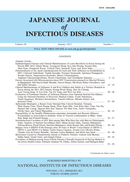Volume 68, Issue 1
Displaying 1-19 of 19 articles from this issue
- |<
- <
- 1
- >
- >|
Original Article
-
Article type: Original Article
2015 Volume 68 Issue 1 Pages 1-4
Published: 2015
Released on J-STAGE: January 26, 2015
Advance online publication: November 25, 2014Download PDF (235K) -
Article type: Original Article
2015 Volume 68 Issue 1 Pages 5-12
Published: 2015
Released on J-STAGE: January 26, 2015
Advance online publication: November 25, 2014Download PDF (342K) -
Factors Associated with Misconceptions about HIV Transmission among Ever-Married Women in BangladeshArticle type: Original Article
2015 Volume 68 Issue 1 Pages 13-19
Published: 2015
Released on J-STAGE: January 26, 2015
Advance online publication: November 25, 2014Download PDF (121K) -
Article type: Original Article
2015 Volume 68 Issue 1 Pages 20-26
Published: 2015
Released on J-STAGE: January 26, 2015
Advance online publication: November 25, 2014Download PDF (232K) -
Article type: Original Article
2015 Volume 68 Issue 1 Pages 27-29
Published: 2015
Released on J-STAGE: January 26, 2015
Advance online publication: November 25, 2014Download PDF (89K) -
Article type: Original Article
2015 Volume 68 Issue 1 Pages 30-32
Published: 2015
Released on J-STAGE: January 26, 2015
Advance online publication: November 25, 2014Download PDF (89K) -
Article type: Original Article
2015 Volume 68 Issue 1 Pages 33-37
Published: 2015
Released on J-STAGE: January 26, 2015
Advance online publication: November 25, 2014Download PDF (95K) -
Article type: Original Article
2015 Volume 68 Issue 1 Pages 38-44
Published: 2015
Released on J-STAGE: January 26, 2015
Advance online publication: November 25, 2014Download PDF (115K) -
Article type: Original Article
2015 Volume 68 Issue 1 Pages 45-49
Published: 2015
Released on J-STAGE: January 26, 2015
Advance online publication: November 25, 2014Download PDF (174K) -
Article type: Original Article
2015 Volume 68 Issue 1 Pages 50-54
Published: 2015
Released on J-STAGE: January 26, 2015
Advance online publication: November 25, 2014Download PDF (104K) -
Article type: Original Article
2015 Volume 68 Issue 1 Pages 55-59
Published: 2015
Released on J-STAGE: January 26, 2015
Advance online publication: November 25, 2014Download PDF (158K)
Short Communication
-
Article type: Short Communication
2015 Volume 68 Issue 1 Pages 60-62
Published: 2015
Released on J-STAGE: January 26, 2015
Advance online publication: November 25, 2014Download PDF (183K) -
Article type: Short Communication
2015 Volume 68 Issue 1 Pages 63-66
Published: 2015
Released on J-STAGE: January 26, 2015
Advance online publication: November 25, 2014Download PDF (174K) -
Article type: Short Communication
2015 Volume 68 Issue 1 Pages 67-69
Published: 2015
Released on J-STAGE: January 26, 2015
Advance online publication: November 25, 2014Download PDF (86K)
Epidemiological Report
-
Article type: Epidemiological Report
2015 Volume 68 Issue 1 Pages 70-74
Published: 2015
Released on J-STAGE: January 26, 2015
Download PDF (239K)
Laboratory and Epidemiology Communications
-
Article type: Laboratory and Epidemiology Communications
2015 Volume 68 Issue 1 Pages 75-76
Published: 2015
Released on J-STAGE: January 26, 2015
Download PDF (82K) -
Article type: Laboratory and Epidemiology Communications
2015 Volume 68 Issue 1 Pages 76-78
Published: 2015
Released on J-STAGE: January 26, 2015
Download PDF (85K) -
Article type: Laboratory and Epidemiology Communications
2015 Volume 68 Issue 1 Pages 78-79
Published: 2015
Released on J-STAGE: January 26, 2015
Download PDF (264K)
Erratum
-
Article type: Erratum
2015 Volume 68 Issue 1 Pages 80
Published: 2015
Released on J-STAGE: January 26, 2015
Download PDF (285K)
- |<
- <
- 1
- >
- >|
